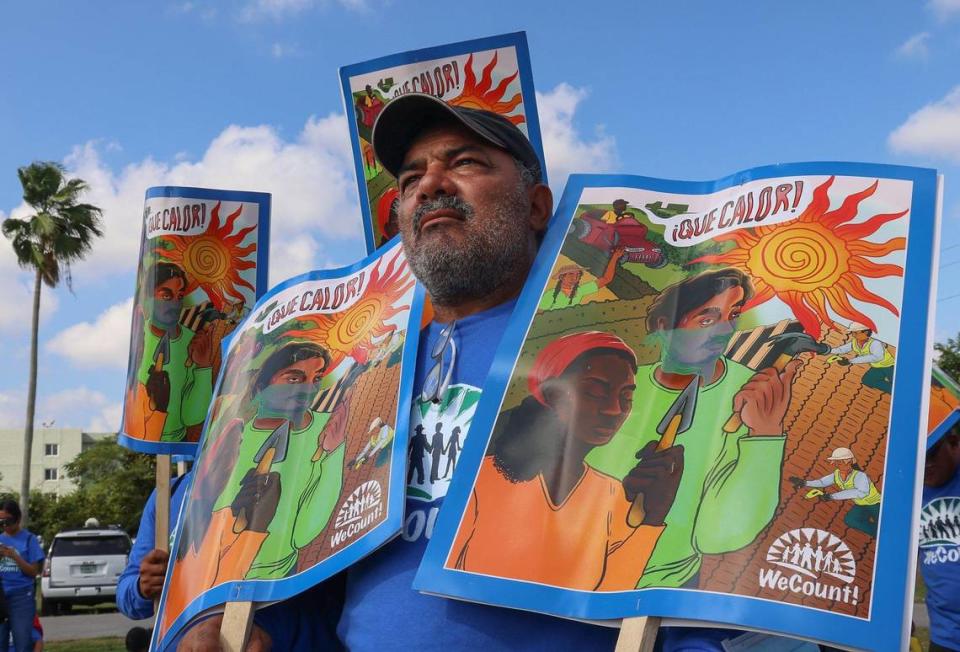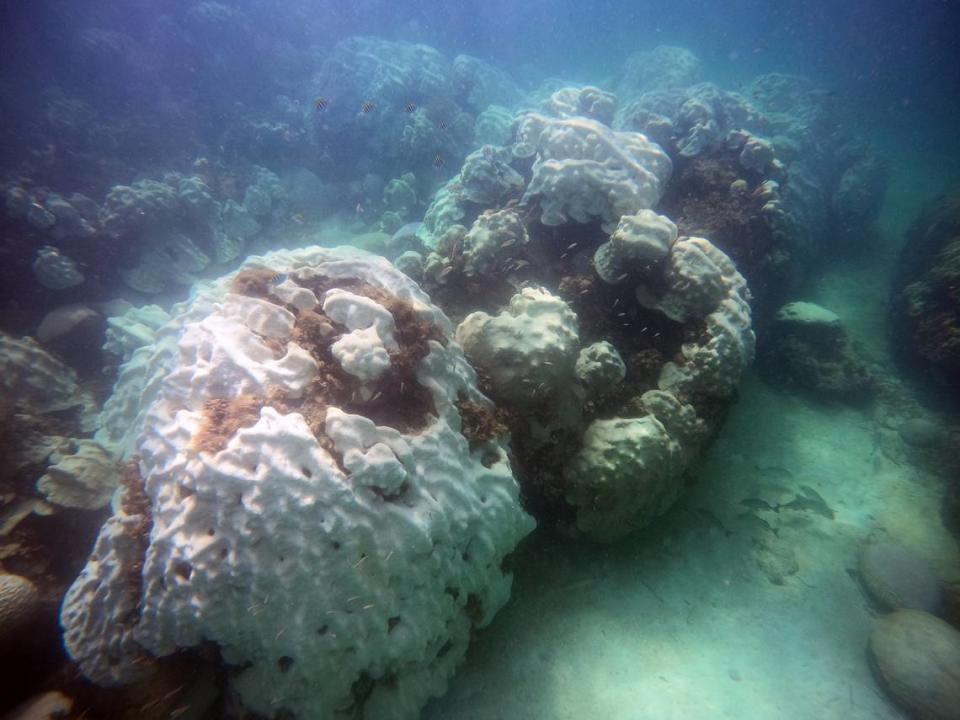46 sweltering days: Miami’s record heat streak offers a glimpse at summers to come
For 46 sweltering days this summer, Miami sizzled under heat index temperatures that topped 100 degrees every afternoon. That shattered the previous record, set in 2020, of 32 days in a row above 100 degrees.
The record-breaking stretch that began June 11 ended July 27, when heavy rains capped the heat index at a mere 98 degrees.
In that time, Miami set 10 daily temperature records, 27 daily heat index records, received its first-ever excessive heat warnings from the National Weather Service and sheltered under 23 days of heat advisories. The earth set a new all-time temperature record — and then broke it three times.
A farmworker in Homestead died on the job and Miami-Dade County introduced a bill meant to protect outdoor workers on extremely hot days. And scientists rushed to rescue bleaching corals as South Florida coastal waters hit jacuzzi temperatures.
“This isn’t just Miami in July heat,” said John Morales, hurricane specialist at NBC 6. “Miami isn’t just breaking its record heat index values — we’re absolutely obliterating the previous records on a daily basis.”

Miami is well on its way to recording the hottest year meteorologists have seen in 130 years of keeping weather records, Morales said. Thanks to climate change, this summer is likely a preview of summers to come.
“This summer should repeat with much greater ease here in South Florida because of the trend of hotter temperatures all around the planet, which is undeniable, and undeniably linked to mankind and our continued burning of fossil fuels,” Morales said.
By 11 a.m. Friday, a few hours after the streak broke, Miami’s heat index was already back up to 100 degrees.
‘A window into our not-too-distant future’
The tale of this summer’s extreme heat — so far — began with the ocean. The main development region of the Atlantic, where most hurricanes are born, was at September-level temperatures as early as June.
That would turn out to be a trend, and foreshadow a June and now July that are shaping up to be the hottest in recorded history. And while climate change can take some of the blame, scientists think the weirdly hot Atlantic was also caused by a low amount of Saharan Dust, which shades the sea surface, and less active trade winds than usual.
Jeff Berardelli, chief meteorologist and climate specialist at Tampa Bay’s WFLA, said the globe has seen several stalled weather patterns this summer, leading to stagnant winds and higher-than-usual heat in places like the United Kingdom, the Mediterranean and Florida.

Berardelli said the Atlantic high, which usually provides a cooling eastern breeze over the state, has been missing in action for the last few weeks, until just a day or so ago. Without that breeze, water temperatures have risen to nearly five degrees above normal in the Florida Keys, taking the waters from coral-safe mid-80s to dangerously hot 90s. In some super shallow spots away from most corals, water temperatures registered 101 degrees Fahrenheit this week, close to an all-time record for the Manatee Bay location in the upper Keys.
“So much of the heat index is caused by a rise in humidity,” Berardelli said. “Combine the fact that you’re not getting a breeze, so your temperature is high and the ambient humidity around Florida is higher because the water is hotter, therefore you end up with this disaster across Florida.”
Another factor leading to this summer’s extreme heat is the switch between two powerful global weather phenomena — El Niño and La Niña.
For the last three years, the world has been in a La Niña phase, where more of the heat is stored in parts of the ocean and hurricane season in the Atlantic is usually more active. Now, we’ve flipped to an El Niño, which may bring some relief for the Atlantic hurricane season but also pairs with a release of much of that stored heat from the world’s oceans.
Small increase in average global temp leads to big increase in local temps. @ClimateCentral pic.twitter.com/9pO3Bj1sPb
— UN Climate Change (@UNFCCC) June 16, 2017
All of that is layered onto the impact of unchecked human-caused climate change, which has warmed the world significantly and, without global action, is set to cook the planet even further for decades to come. While that does indicate future summers will be hotter and hotter, scientists say the future trend looks more like a line with wiggles around it to indicate that some years will be below average and others will be above. But the overall trend is headed upward.
“This is a window into what every summer is going to look like a couple decades from now, but this is an aberration in the short term,” Berardelli said. “At some point that upward trend will be equal to this aberration. When you add another aberration to those summers, then you’re going to get a lot more extreme heat than this summer.”
“This is a window into our not-too-distant future. Probably in less than a generation, these are going to be normal summers. We won’t be surprised anymore by what’s happening,” he said.
Calls for change after farmworker death
South Florida’s hot summer weather can have deadly consequences — especially for vulnerable groups like outdoor workers, people who don’t have air-conditioning, and people who are elderly, pregnant, homeless or have a disability.
“Folks that live in humid cities like Miami have a lot to worry about because the humidity really impacts the ability of the human body to be able to adjust to the heat,” Morales said. “If the body cannot sweat and have that sweat evaporate off your skin with ease, then people start to overheat.”
“Once your core temp starts to rise beyond a certain level, you’re going to suffer ill consequences of excessive heat,” he said.
Around midday on July 6, as the heat index climbed toward 106 degrees, a 29-year-old farmworker named Efraín López García collapsed on a tropical fruit farm in Homestead. His family said he died of heatstroke, although a medical examiner’s report is still pending.
Two weeks later, Miami-Dade County commissioners introduced a bill designed to protect outdoor workers from unsafe conditions on hot days. It would require companies to give workers water and 10-minute, shaded breaks every two hours when the heat index hits 90 degrees or more. Also, it would also require companies to train their employees to recognize the signs of heat illness and give first aid.
Workers organized by the advocacy group WeCount! had been pushing for the bill for two years. It now faces a hearing in front of the commission’s Health Committee on Sept. 11 and must pass a final vote before the full commission to become law.
“We’re asking for the bare minimum, which is water, shade and rest — the right to go to work and to return home alive,” said WeCount! co-executive director Oscar Londoño.

On Thursday, President Joe Biden said the U.S. Department of Labor would start issuing warnings to outdoor workers and their employers on hot days and step up its workplace inspections to find companies putting employees in dangerous conditions.
Local advocates said the White House move is a step in the right direction, but doesn’t go far enough. “I don’t know why it took them so long to do this, but they need to act quicker because things are only getting worse,” said Yvette Cruz of the Florida Farmworker Association. “This has been the worst summer so far and I don’t want next summer to be even worse. I fear for more lives.”
‘Goodbye’ to the reefs
The extraordinary heat, especially in the ocean, has driven an unprecedented die-off of corals along Florida’s already battered reef tract. Coral scientists said they’ve never seen heat like this. It’s earlier than ever, higher than usual and has lasted longer than most bleaching events in the past.
That’s bad news for corals, which can survive short bursts of very high heat or longer stretches of slightly warm temperatures, but struggle and die when temperatures are elevated for long periods. And with water temps running in the mid-90s, instead of the coral-safe mid-80s, for nearly two months straight, researchers are already seeing “apocalyptic” levels of coral bleaching and death.

Katey Lesneski, a researcher with the Florida Keys National Marine Sanctuary, tweeted photos of the ghost-white reefs off Horseshoe Key in Key Largo this week, all bleached and dead from the extreme temperatures.
“I said my goodbyes to this reef and will continue to document as much as I can in the coming weeks. Unfortunately, we are braced for a continual nightmare,” she tweeted.
Phanor Montoya-Maya, the restoration program manager at Coral Restoration Foundation, raised the prospect of “local extinction” of some species of elkhorn and staghorn coral, important reef builders that make up the backbone of much of South Florida’s reef tract.
Sea SurfaceTemperature graphs for the Florida Keys 1985-present. Note two things - First, the temperature has been getting warmer decade by decade. Second, this years temp is the hottest ever recorded (in black). Blue horizontal line across the graph is the bleaching threshold. pic.twitter.com/27hzPyjXQ9
— Bill Precht (@BillPrecht) July 27, 2023
Montoya-Maya and other scientists have been rushing for the last few weeks to collect all of the coral fragments growing in offshore artificial nurseries and bring them to land-based aquariums, along with some species of wild coral on natural reefs, both as a source of future material to replant when the water cools and as a future gene bank in case of total destruction.
“This tank may well hold the last representation of the genetic populations of Elkhorn and Staghorn corals in the entire Florida Reef Tract,” he tweeted Thursday, alongside a picture of dozens of coral chunks bathed in blue aquarium light.
“Coral reef restoration has not failed,” he posted. “Thanks to all the efforts that for decades, several restoration practitioners and management agencies have undertaken to propagate these two species, we may have saved these species from local extinction!”
This climate report is funded by Florida International University, the Knight Foundation and the David and Christina Martin Family Foundation in partnership with Journalism Funding Partners. The Miami Herald retains editorial control of all content.
